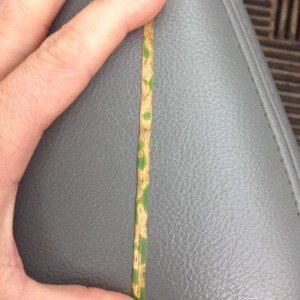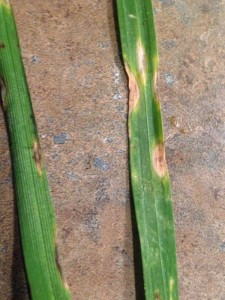We continue to struggle with tough conditions for some winter annuals. We are seeing some challenges locally in rye planted for forage and seed. I have only observed this in Wrens Abruzzi, but was informed Florida 401 would likely be more susceptible to foliar disease, but am not aware of any planted locally due to seed shortages. We should be paying attention to our wheat and triticale plantings as well. Our default recommendation for foliar diseases is “graze it.” However, we have seen a few instances where it is too early for grazing at only 30-40 days old. Forage agronomists usually recommend a minimum of 45 days growth, and prefer we allow 60 days for establishment before grazing. This offers the best season long performance of planted forage. We have additional instances where rye is being grown for seed patch, or seed for sale as a cash crop. Grazing is not feasible in those cases.
My colleague, Dan Fenneman, with UF/IFAS Extension Madison County, submitted samples to the plant pathology lab for confirmation.
| Diagnosis: | Spot Blotch (Bipolaris sorokiniana) |
| Comments: | Bipolaris spp. was detected from both: dark brown small spots and light brown larger spots. Also known as Helminthosporium sativum or Cochliobolus sativus, this fungus causes leaf spot, seedling blight, head blight and root rot. Abundant (hundreds of spores) sporulation was observed on the leaves after 3-4 days incubation in moist chamber. SYMPTOMS Leaf spots are light to dark brown in color, oval, lens shape to somewhat elongate, and have definite margins. Older spots have an olive color due to spore production. Individual spots coalesce to form blotches. Sometimes this fungus also causes large brown, somewhat water-soaked lesions in the leaf sheaths near the soil surface. This problem is more severe when rye or triticale is planted nearby. HOST RANGE Wheat, barley, triticale, rye and numerous crop and weed species. |
I reached out to Dr. Nicholas Dufault, UF/IFAS Extension Plant Pathologist, for recommendations in situations where grazing is not applicable. Dr. Dufault said,” There are not going to be a lot products for cereal rye, but some of the most common are Tilt and Headline . You will also have Quadris, Quilt and Quilt Excel that are labeled for Rye. Products containing a group 11 fungicide will generally perform better. That being said, if you are considering only 1 spray, I would consider premixed (e.g. Quilt or Quilt Excel) product with a FRAC group 11 & 3. Overall, after the disease is established it will be hard to control. However, a fungicide application can provide help protecting some of the new leaves on the plant. Of course the feeding/grazing/harvesting restrictions will vary from label to label, so it will be important to check this when making the decision on what to spray.” 
Thanks to Extension Agent Fenneman and Travis Page from Farmers Cooperative-Madison for keeping me abreast of their observations from Madison County.
It is not the intent of the author to recommend specific brand products. Please discuss your labeled chemical options with your chemical dealer or representative.

